|
 |
 |
New FOMC countdown begins
Econoday Simply Economics 8/25/00
By Evelina M. Tainer, Chief Economist |
The Federal Open Market Committee (FOMC) left rates unchanged at their meeting this past week, as widely anticipated by financial market players. The accompanying policy statement said the risk towards inflation was still a concern. However, the statement also focused on the slowdown in aggregate demand as well as the improved productivity figures. All in all, market players viewed the statement in a friendly light. In an interesting addendum, though, the minutes of the June FOMC meeting suggested that Fed officials didn't believe they were through with the tightening cycle even though they had voted unanimously to leave rates unchanged. It will be interesting to see if these views had changed by August. These minutes won't be available until early October. In the meantime, market players don't expect the Fed to raise rates in advance of the November election. Some analysts have gone so far as to proclaim that the next move will be an ease. It is all too early to tell.
Equities improve on thin markets
Equity prices drifted higher this past week continuing the trend of the past couple of weeks. Perhaps market players were relieved that the Fed left rates unchanged at the FOMC meeting, although it was in line with expectations. It was a slow week from an economic perspective. Few indicators were reported - and all came at the end of the week. Market players might be relieved that the Verizon telecom workers strike was settled. United airline pilots are still in negotiations, but both sides are feeling more comfortable this past week and expect the labor contract to be settled near Labor Day.
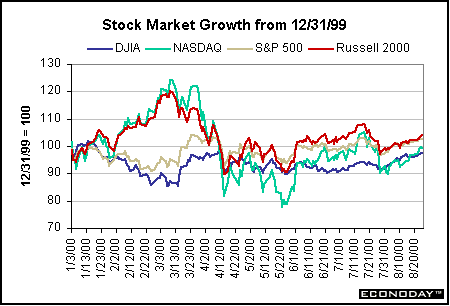
While all market indices are showing improvement these days, the S&P 500 and the Russell 2000 are outpacing the NASDAQ composite and the Dow Jones Industrials relative to year end 1999.
Treasury yields edge lower
Treasury yields have remained in a fairly tight range these past couple of weeks. Sometimes economic indicators cause little upticks in the yield, sometimes they allow yields to drift slightly lower. Although the Fed's decision to leave rates unchanged wasn't a surprise this week, yields drifted lower after the announcement. Markets were thin ahead of the Labor Day holiday, and economic indicators were sparse.
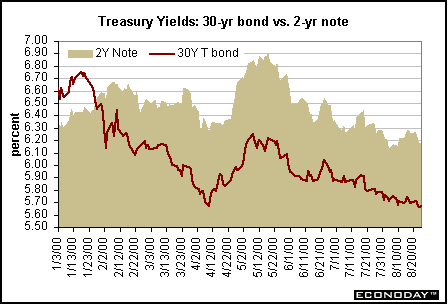
Markets
at a Glance
|
| Treasury Securities |
12/31/99 |
2000
High |
2000
Low |
18-Aug |
25-Aug |
Week %
Change |
| 30-year Bond |
6.48% |
6.75% |
5.70% |
5.69% |
5.67% |
-0.02% |
| 10-year Note |
6.43% |
6.77% |
5.78% |
5.77% |
5.72% |
-0.05% |
| 5-year Note |
6.34% |
6.81% |
6.01% |
6.08% |
6.00% |
-0.08% |
| 2-year Note |
6.24% |
6.90% |
6.13% |
6.26% |
6.18% |
-0.08% |
| |
|
|
|
|
|
|
| Fed Funds Rate Target |
5.50% |
6.50% |
5.50% |
6.50% |
6.50% |
0.00% |
| |
|
|
|
|
|
|
| Stock
Prices |
|
|
|
|
|
|
| DJIA |
11497 |
11723 |
9811 |
11046 |
11193 |
1.3% |
| S&P 500 |
1469 |
1524 |
1348 |
1492 |
1506 |
1.0% |
| NASDAQ Composite |
4069 |
5049 |
3164 |
3930 |
4043 |
2.9% |
| Russell 2000 |
505 |
606 |
457 |
516 |
525 |
1.9% |
| Wilshier 5000 |
13813 |
14751 |
12475 |
13907 |
14091 |
1.3% |
| |
|
|
|
|
|
|
| Exchange
Rates |
|
|
|
|
|
|
| Euro/$ |
1.0008 |
0.8893 |
1.0336 |
0.9064 |
0.9020 |
-0.5% |
| Yen/$ |
102.40 |
111.35 |
101.45 |
108.42 |
107.04 |
-1.3% |
| |
|
|
|
|
|
|
| Commodity
Prices |
|
|
|
|
|
|
| Crude Oil ($/barrel) |
$25.60 |
$34.05 |
$21.20 |
$31.95 |
$32.05 |
0.3% |
| Gold ($/ounce) |
$289.60 |
$326.00 |
$273.90 |
$281.80 |
$278.70 |
-1.1% |
| |
|
|
|
|
|
|
Home sales plunge
Existing single family home sales plunged 9.8 percent in July to a 4.79 million-unit rate. This was much weaker than predicted by economists and more than offsets the moderate 4.3 percent gain reported for June. Sales are down 9.8 percent from year ago levels as well. As indicated in the chart below, sales are clearly on a downward trend. It is likely that home sales have weakened in the past year as mortgage rates have risen nearly 2 percentage points. Mortgage rates are down from their peak (8.5 percent) of a few months ago, but still very near the psychological barrier of 8 percent.
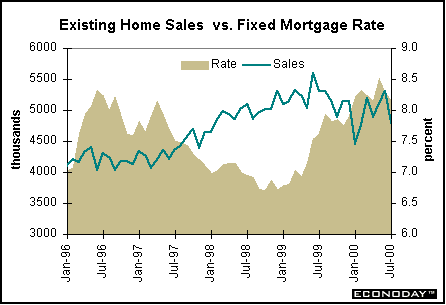
The bottom-line on home sales? The overall level of housing activity is still quite robust and indicative of a healthy economy. However, sales have come off from their peak and this will encourage Fed officials that their rate hikes of the past year have affected consumer demand. Indeed, the slower pace of home sales eventually reduces the demand for furniture and appliances. Retail sales have already moderated in these sectors. The housing data supports the Fed's decision this past week to leave rates unchanged. Furthermore, it sets the stage for a more friendly environment for the Fed in coming months - one where they can maintain current policy.
Durable goods new orders plunge
New orders for durable goods plummeted 12.4 percent in July - wiping out completely June's 9.5 percent gain. In both cases, the culprit of the sharp swings was the old standby: aircraft orders, surging 85.3 percent in June and plunging 49.2 percent in July. While a drop in aircraft orders did account for the bulk of the decline in new orders in July, it wasn't entirely responsible for the weakness in other sectors. For instance, primary metals and electronic equipment also declined during the month. But these followed stronger months and thus aren't indicative of a new anemic trend.
It is always useful to look at durable goods orders in a broader context. The chart below takes a three-month average of the year-over-year change in total orders and nondefense capital goods orders. Note that the latest three-month trend - which includes this horrific drop in July - still reflects a pretty decent growth pace. While production is likely to soften eventually from the weaker orders, at least for the next few months, producers are still working off orders from the past spring
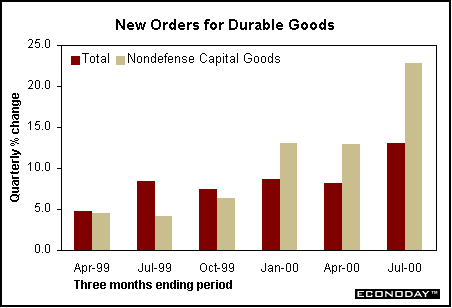
The bottom-line on manufacturing? New orders may have plunged in July - perhaps suggesting that manufacturing activity may soften in the next few months. However, these figures fluctuate dramatically from one month to the next. A broader perspective reveals that activity was still accelerating in the most recent three-month period.
GDP marginally higher; final sales much lower
The Commerce Department reported that real GDP expanded at a 5.3 percent rate in the second quarter - not really different from the advance estimate (5.2 percent). More significant was the sharp downward revision in final demand. Real final sales grew at a 3.5 percent rate in the second quarter - less than the 4.2 percent rate initially estimated and nearly half the 6.7 percent rate recorded in the first quarter. The combination of slightly higher GDP coupled with softer final sales growth left inventories at a higher level. Indeed, inventory building accelerated at nearly twice the first quarter pace. When sales demand moderates at the same time that inventories are building, one is left with the question of whether the inventory stock up was planned or not. If the inventory buildup is not desired by retailers and manufacturers, it means that production may be scaled back going forward into the next few months.
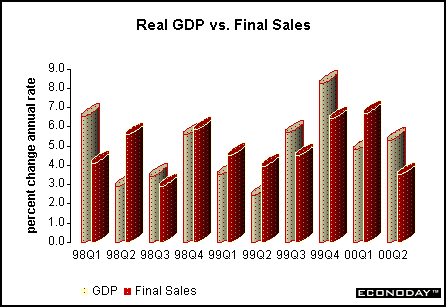
Corporate profits were looking pretty good in the second quarter. After-tax profits grew 17.2 percent in the second quarter from the year earlier period. This was exactly the growth average of the previous two quarters. But while profits were good in the first half of the year, analysts are projecting slower gains in the second half. Indeed, if second-half forecasts are realized that real GDP will moderate to a 3.5 to 4 percent pace, it certainly means that revenues and earnings will soften as well.
The chart below compares yearly growth in profits with the annual change in the Dow Jones Industrials. Notice that the last time the Dow decreased on an annual basis (in 1998), profit growth was negative as well. Perhaps we won't see declining profits in the second half of 2000, but weaker gains appear in the cards.

The bottom-line on growth? The moderation in aggregate demand coupled with a subdued inflation environment (the real GDP deflator rose at a 2.6 percent rate in the second quarter, down from the first quarter's pace of 3.3 percent) will reassure Fed officials that the decision to leave rates unchanged at the June and August meetings was appropriate. Fed officials are likely hoping that the trend set in the second quarter continues and permits them to remain on the sidelines at the October FOMC meeting as well. While slower economic growth bodes well for the bond market, equity investors will be less inclined to favor these figures, which lead to decreasing revenues.
THE BOTTOM
LINE
As widely expected, the Federal Reserve left its federal funds rate target unchanged at 6.5 percent (and its discount rate unchanged at 6 percent) at the end of the August 22 FOMC meeting. The FOMC announcement noted that the balance of risks still favored heightened inflationary expectations, but it also mentioned slower aggregate demand and healthy productivity growth. Market players now expect the Fed to remain on hold ahead of the November elections - and perhaps after it as well should the economy slow more decidedly.
This week's set of economic news was in line with the view that economic activity is slowing - both existing home sales and durable goods orders plummeted in July. While second quarter GDP growth was healthy, it also showed softer demand coupled with rising inventories. This is a recipe for a slowdown.
Looking
Ahead: Week of August 28 to September 1
Market News International compiles this market consensus which surveys about 15 economists each week.
Monday
Economists are predicting that personal income will increase 0.4 percent in July, the same as in June. This is based on the moderate gains in nonfarm payrolls and wages. (Forecast range: 0.3 to 0.6 percent) Personal consumption expenditures are expected to rise 0.5 percent in July, the same as the previous month. This incorporates the 0.7 percent rise in retail sales and includes spending on services as well. (Forecast range: 0.4 to 0.6 percent)
Tuesday
The Conference Board's consumer confidence index is expected to inch down to 141.0 in August from the July level of 141.7. Consumers remain quite optimistic about economic conditions - and why shouldn't they - with a low unemployment rate and subdued inflation. (Forecast range: 140 to 143)
New home sales should increase 1.3 percent in July to an 840,000-unit rate after recording a 3.7 percent drop in June. This is in sharp contrast to the nearly 10 percent drop posted in existing home sales last week. However, new home sales have been more anemic over the past several months already, so a large drop may not be in the cards. (Forecast range: 799,000 to 860,000)
Wednesday
The consensus forecast calls for a 0.1 percent decline in the Conference Board's index of leading indicators in July. This would match the May reading. In June, the index had remained unchanged. While the index is not reflecting an economic downturn, it is consistent with some moderation in the pace of economic activity - particularly in the manufacturing sector. (Forecast range: 0.0 to -0.2 percent)
Thursday
Market participants are expecting new jobless claims to edge down 4,000 in the week ended August 25 from last week's 314,000 level. (Forecast range: -14,000 to +6,000)
The consensus forecast is looking for factory orders to drop 7.0 percent in July more than reversing the 5.5 percent gain posted in June. This is mainly due to the volatile aircraft sector. New orders should continue their moderate upward trend otherwise. (Forecast range: -4.7 to -7.2 percent)
Economists are predicting that the Chicago purchasing managers' survey will edge up to 53.5 in August from a level of 52 in July. This reflects a moderate pace of manufacturing activity in the Chicago region. Market players also focus on the prices paid index. It stood at 70 in July.
Friday
The consensus forecast is looking for nonfarm payroll employment remains unchanged in August after a 108,000 gain in July. This still reflects declines in temporary Census workers. (Forecast range: -58,000 to +85,000) Excluding the Census group, economists expect a 125,000 gain in payrolls. (Forecast range: 42,000 to +170,000)
The unemployment rate should remain unchanged at a 4 percent. (Forecast range: 3.9 to 4.1 percent) Average hourly earnings are predicted to rise 0.3 percent in August - less than the 0.4 percent gain recorded last month. (Forecast range: 0.2 to 0.4 percent) The average workweek is expected to inch up to 34.5 hours from 34.4 hours in July. (Forecast range: 34.4 to 34.5)
The NAPM survey is expected to edge up to 52 in August from a level of 51.8 in July. Any level above 50 percent still represents a growing manufacturing sector. Market players are also focusing on the prices paid index - which stood at 61.9 in July. (Forecast range: 50.8 to 53.0) The consensus of economists that predicts this number is looking for a rise to 62.4. (Forecast range: 58 to 65.0)
Market participants are looking for a 0.5 percent rise in construction spending in July after a 1.7 percent decline in June. This still reflects a downward drift in new housing construction. Overall construction activity still remains relatively healthy.
|








